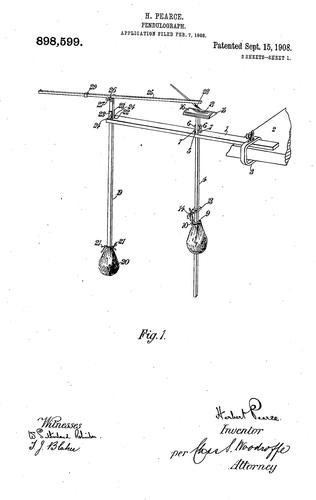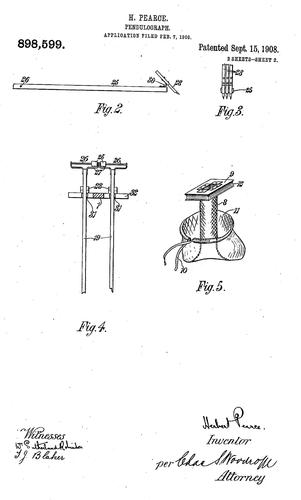Harmonograph Related US Patents
Tracing the History of Harmonograph Patents
A historical overview of the Harmonograph would not be complete without taking a broad look at some of the more interesting Harmonograph related patents registered with the United States Trademark and Patent Office. Researching Harmonograph related patent documents is a fairly straightforward because the rules governing the issuance of patents requires that applicants conduct a thorough search of all previously issued patents to insure that they are not infringing on the rights of an earlier registered patent. United States Patents must contain references to these previously issued patents which are revealed during the patent search process. By researching these patent references, one can get an idea of the evolution of any patented object including pendulum drawing devices.
Copyrights are administered by the Copyright Office, a division of the Library of Congress. Copyright law (17 U.S.C. § 105) states that all materials created by the
Patents are published as part of the terms of granting a patent to the inventor. Subject to limited exceptions reflected in 37 CFR 1.71(d) & (e). An inventor’s right to exclude others from making, using, offering for sale, or selling their invention throughout the
If you wish to incorporate any proprietary features found in a previously patented or copyrighted product into your design; you must do so legally and in a way that does not infringe on the legal rights of the patent or copyright holder.
__________________________________________________________________
| USPO Number | Inventor(s) Name | Date of Patent | Invention |
898,599 | H. Pearce | Sept. 15, 1908 | Pendulograph |
1,869,951 | G. E. Worthington | Aug. 2, 1932 | Pendulum Toy |
3,143,807 | G. L. Christie | Aug. 11, 1964 | Pendulum Drawing Device |
3,324,556 | G. Everett | June 13, 1967 | Pendulum Toy |
3,384,966 | E. J. Lias | May 28,1968 | Pendulum Toy |
3,473,229 | I. Moscovich | Oct. 21, 1969 | Harmonograph |
3,494,037 | A. Arber | Feb. 10, 1970 | Pendulum Actuated Drawing Instrument |
3,496,641 | G. W. Mills | Feb. 24, 1970 | Harmonograph |
3,521,360 | T. E. Wolf | July 21, 1970 | Coin-operated Harmonograph |
3,590,488 | Miron Padowicz | July 6, 1971 | Apparatus for Tracing Random Geometrical Figures |
3,977,085 | R. L. Sandifer | Aug. 31, 1976 | Pendulum Toy |
4,067,111 | T. E. Truitt | Jan. 10, 1978 | Pendulum Device |
4,162,477 | M. A. Cosman | July 31, 1979 | Pendulum Drawing Machine |
4,199,867 | G. Cass | Apr. 29, 1980 | Harmonograph |
4,199,868 | R. J. Steward | Apr. 29, 1980 | Amusement Device for Tracing Geometrical Figures |
4,703,562 | D. H. Burkholder D. M. Bonsness | Nov. 3, 1987 | Pendulum Design Machine |
4,928,625 | W. A. Woods | May 29, 1990 | Pendulum Mounted Airbrush |
The Term "Harmonograph"
Etymology:
HARMONO- late 14c., from O.Fr. armonie, from L. harmonia, from Gk. harmonia "agreement, concord of sounds," lit. "means of joining," related to harmos "joint, shoulder," from PIE *ar-ti-, from *ar- "to fit together." Musical sense is oldest in
Popular Usage:
When this Patent was applied for, there was no common term used to define pendulum drawing devices and Pendulograph was one of several popular names then in use. Other inventors sometimes created unique nomenclature or applied their own name's to these devices until around 1951 when the term Harmonograph became somewhat standardized. This was likely due, in part, to the use of the term “Harmonograph” by Cundy and Rollett in their popular book Mathematical Models; which is now, unfortunately, out of print.The very first Harmonograph related and oft cited patent found by the author is for a "Pendulograph" patented in 1908. This patent offered specific design improvements over other pendulum drawing toys then in use, and today we would call this type of Harmonograph a Lissajous Figure Drawing Machine.
Click on the images below to view the entire patent -

